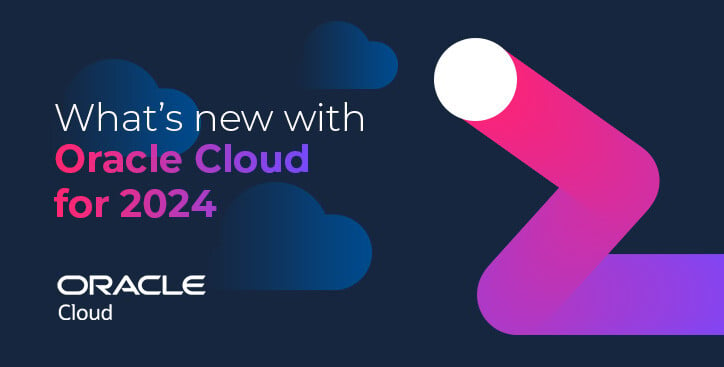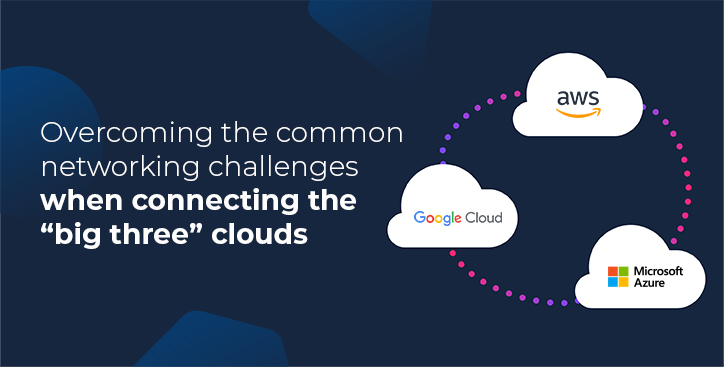What’s new with Oracle Cloud for 2024
By Lily Bennett|9 September, 2024

Following on from Oracle CloudWorld - a three-day event focused on cloud innovation, automation, and AI - we take a look at the innovation and growth Oracle Cloud has embarked on this year.
Oracle Cloud Infrastructure (OCI) has experienced notable growth in fiscal year 2024. According to Oracle’s Q4 results, Cloud Revenue (IaaS plus SaaS) reached $5.3 billion, marking a 20% increase in both USD and constant currency.
This growth was accelerated by continued multi cloud cooperation with Microsoft and a surge in demand for training AI models. Find out more about Oracle’s achievements and what’s on the horizon below.
Interconnecting all the clouds
Oracle has adopted a partner-centric approach to the cloud ecosystem, revealing itself as one of the providers that really gets the fact that multi-cloud both in terms of infrastructure and apps, is the typical approach most enterprises are taking.
In fact, Larry Ellison, current CTO of Oracle and one of the original founders, commented on this phenomenon in the company’s most recent earnings call for FY2025, saying: "Customers are using multiple clouds, not only infrastructure clouds, but they might have Salesforce applications or Workday applications, or they use multiple clouds in their business right now. We think that all the clouds are becoming interconnected.”
Oracle already has cloud interconnection partnerships with Microsoft Azure and Google Cloud and Ellison said “We'd love to do the same thing with AWS.”
He added: “We think we should be interconnected to everybody. And that's what we're attempting to do within our multi-cloud strategy. I think that's what customers want,” he said, hinting that provider-level interconnection would potentially alleviate or even get rid of the egress fees enterprises face when moving data from one cloud to another.
Partnerships with Azure and Google Cloud
Earlier this year, Oracle expanded its existing partnership with Microsoft Azure. What began as a way for customers to embrace the best-of-breed model for stacks that use the common combination of Microsoft Windows application front ends with Oracle Database back ends, now means that Oracle Database services can take better advantage of the interconnected infrastructure.
Managed Oracle Database services can now reside inside Azure’s data centre, significantly improving throughput latency of applications using both clouds.
In another partnership with Google, this summer Oracle announced Oracle Interconnect for Google Cloud, directly connecting OCI and Google Cloud in 11 commercial regions globally.
This is an integrated cloud experience using OCI FastConnect and Google Cloud Interconnect, enabling customers to run mission-critical enterprise workloads across Google Cloud and OCI environments using a dedicated, low-latency private connection.
It is these partnerships that have paved the way for Oracle to embed itself in the AI ecosystem. Under another deal with Microsoft, OpenAI will use OCI for additional capacity as Oracle's cloud infrastructure is used to extend the Microsoft Azure AI Platform. OpenAI currently needs all the capacity it can get with the company scaling fast in terms of training models and adoption of its ChatGPT services.
Oracle AI companion
In other AI news, in the early summer Oracle introduced its own AI companion, Oracle Code Assist, to boost developer velocity.
Powered by large language models (LLMs) on OCI and fine-tuned and optimised for Java, SQL, and application development, Oracle Code Assist provides developers with context-specific suggestions tailored to your organisation’s best practices and codebases.
This builds on previous announcements from 2023, which introduced Oracle’s own Generative AI service that aims to embed AI capabilities within Oracle Fusion Cloud Applications and creates a continuous feedback loop that drives a faster innovation cycle.
Joining the big three
In December 2023, Gartner named Oracle a leader in its Magic Quadrant for Strategic Cloud Platform Services, putting Oracle in the same corner as the big three.
The analyst said that while Oracle has leveraged its leadership in the database and ERP markets to grow its cloud market share through existing Oracle application customers, OCI has begun to attract a healthy customer base of its own through innovation.
Focusing on differentiating itself from other providers through its enhanced support for Oracle Applications, the cloud provider has also established aggressive IaaS pricing, its penetration into the multi-cloud services space, and variety of sovereign cloud options.
As well as hyperscale size cloud environments, Oracle also focuses a lot of attention on its ability to build small - giving customers or market sectors access to full cloud capabilities within defined regions or private data centres.
One example of this is Oracle EU Sovereign Cloud for use by both private and public sector organisations, which delivers OCI cloud regions located only within the geographic boundaries of the EU, making it ideal for highly regulated industries.
Another example is OCI Dedicated Region, which delivers a self-contained OCI cloud region in the customer’s data centre or colocation facility, meeting the highest requirements around security, compliance and data locality at scale.
New Oracle regions
Something else OCI is recognised for is its consistency. Every OCI region is identical in terms of infrastructure, connectivity, security and portfolio of services, which is not always true of other providers and is an important provision for customers looking to expand rapidly or wanting to deploy workloads across multiple regions without needing to consider what the capabilities of specific data centres are.
Over the course of 2024, OCI has added several new regions, including:
Saudi Arabia
A new public cloud region in Riyadh is Oracle’s second cloud region in Saudi Arabia and part of a $1.5bon investment agreement between Oracle and the state to meet the rapidly growing demand for AI and cloud services and in line with Saudi Vision 2030.
Morocco
Oracle announced that it is working in partnership with data centre operator N+One to deploy OCI infrastructure in one of N+One's data centres in Morocco to comply with Morocco's specific data sovereignty requirements.
Oracle opened its first cloud region in Africa in 2022, in Johannesburg, South Africa, and also has plans to open a regional instance in Nairobi, Kenya in the future.
Spain
Under a $1bn investment, Oracle plans to open its third cloud region in Spain, focusing on the financial services sector. The new deployment will be based in Madrid in a Telefónica España data centre and will enable compliance with regulations like the Digital Operational Resilience Act (DORA) and European Outsourcing Guidelines.
Singapore
Oracle launched its second cloud region in Singapore, earlier this year to meet rapidly growing demand for AI and cloud services after the company opened its first cloud region in November 2021.
The new Singaporean region already has FastConnect partners including Console Connect.
Your global Oracle Cloud FastConnect partner
As Oracle Cloud continues to emphasise interconnectedness, cloud partnerships, and AI-driven innovation, Console Connect is the ideal partner in driving this growth. With Oracle’s expanding global footprint, Console Connect has extended its reach to even more Oracle Cloud Infrastructure (OCI) locations, making it easier than ever for enterprises to connect to Oracle's rapidly growing cloud regions.
As an Oracle Cloud FastConnect partner, Console Connect can improve access to Oracle Cloud while simplifying network management and reducing costs - all while using a private and protected fibre backbone.
Get in touch to find out more and learn how to:
- Easily build an Oracle Cloud FastConnect network and interconnect with other clouds.
- Connect privately from edge to cloud, linking devices, enterprise locations, and data centres.
- Scale bandwidth and connections to meet the needs of generative AI, including accessing data lakes and supporting disaster recovery.
.jpg)





.jpg)

